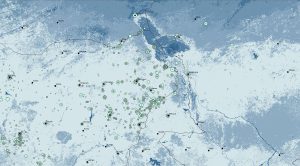By John Weidner and Olivier Walther, University of Florida
5 May 2023

Early warning systems capable of monitoring and forecasting armed conflicts, genocides and other episodes of political violence have proliferated in the last decade, thanks to recent advances in computer science and the growing availability of geo-referenced data. This article examines some of the most promising attempts to predict political violence, with a particular focus on Africa.
Recent advances in conflict monitoring and forecasting
A proliferation of disaggregated spatial data has led to a renewed interest in conflict studies for monitoring and forecasting the onset, duration and termination of political violence. Today, most early warning systems use a small number of global datasets that provide detailed information on thousands of conflict events and fatalities around the world, improving the reliability of conflict forecasting. Among the most popular datasets are the Uppsala Conflict Data Program (UCDP) that records violent conflicts since the 1970s, and the Armed Conflict Location & Event Data Project (ACLED) that provides disaggregated conflict data since 1997.
In the academic sphere, one of the most widely used models is the Violence & Impacts Early-Warning System (ViEWS), which publishes regular conflict forecasts based on UCDP data and numerous other sources, such as news reports and socio-economic data. ViEWS focuses on Africa and the Middle East, where most asymmetric conflicts occur today. Its team recently launched a forecasting competition to predict the intensity of violence caused by state-based conflicts in Africa. The results suggest that predicting the beginning and end of a conflict remains challenging. Early warning systems that contain as few predictors as possible, such as the Dynamics model, tend to be as successful at predicting episodes of violence as those which combine large numbers of variables.
Some early warning systems have been developed to investigate specific types of violence. The Atrocity Forecasting Project (AFP), for example, predicts the development of genocide based on the probability of political instability observed in a given state. Other models have a more environmental approach and focus on access to and management of natural resources. The Water, Security and Peace (WSP) early warning system, for example, suggests that water data can significantly help predict violence one year in advance.
A few models incorporate climate predictions from the Intergovernmental Panel on Climate Change (IPCC) and conflict data from ACLED to predict armed conflict with a high spatial resolution. In West Africa, the most widely used model is the Famine Early Warning Systems Network (FEWS NET) designed to identify hotspots of food crises and promote food security across the region.
In the policy sphere, numerous international organisations, regional blocs, and countries have developed their own early warning systems. The Global Conflict Risk Index (GCRI), for example, is actively used by the European Commission to design conflict prevention strategies. The model is comprehensive in its thematic coverage of independent variables, relies on UCDP data and is parsimonious compared to other global models such as ViEWS. Similar initiatives were developed in the United States in the last decades, with the Integrated Crisis Early Warning System (ICEWS) for example, a model that combines agent-based models, logistic regression, and geospatial networks. Germany’s Federal Foreign Office has implemented a model with nearly global coverage, called PREVIEW, to help policy makers understand the evolution of conflict, for example in the West African Sahel region. Finally, the OECD has launched a new Spatial Conflict Dynamics indicator (SCDi) to monitor changes in the geography of conflicts in North and West Africa, which can potentially be used to identify emerging hotspots of violence, as in northwest Nigeria today.
New directions
In recent years, progress in early warning systems has followed several promising directions.
First, an increasing number of researchers have developed statistical models that rely on past records of violent events and are tested against future, out-of-sample data. This approach is well adapted to countries where data can be hard to find, such as Liberia, where panel surveys have been used to predict collective, interpersonal and extrajudicial violence one year into the future using machine learning techniques.
Another interesting approach is to use subnational data to predict violence at the national level, where ethnic divisions, inequalities, political discrimination and wealth differentials often lead to violence. This method can help predict the onset of civil war and termination in countries where numerous state and non-state actors are in conflict, as in certain African countries today.
Challenges ahead
One key challenge faced by early warning systems is how to predict new outbreaks or escalations of violence. Despite the growing availability of fine-grained data, the probability of observing new episodes of violence in previously peaceful regions remains very low, an issue referred to in conflict studies as the “hard problem of conflict prevention”. To address this issue, models that focus on conflict onset tend to use “random forest” techniques that can predict conflict probability based on numerous choices, or decision trees, that a machine can learn to make.
Another key challenge is to predict conflict with a high spatial resolution. This is particularly important in Africa, where armed conflicts often have local roots and can affect specific parts of a country, such as borderlands or secondary cities. Thus far, most early warning systems forecast violence at the national level, such as the model developed by the United States Holocaust Museum to predict the risk of mass atrocities, for example.
To address this issue, ACLED has recently launched a series of early warning and forecasting tools at different scales. ACLED’s Conflict Alert System (CAST) predicts political violence events up to six months in the future for every country in the world and for each first-order administrative division. The platform also provides Subnational Threat & Surge Trackers to pinpoint local-level spikes in violence and publishes a Volatility & Risk Predictability Index (VRPI) that quantifies the predictability and stability of the overall conflict rate at both the national and subnational levels.
In sum, early warning systems have become increasingly accurate spatially but also far more complex than ever, thanks to the growing availability of data and development of predictive models. Machine learning models offer a wealth of technical possibilities by integrating many factors that can contribute to the onset of conflict, but they also come with limited interpretability. In the coming years, one of the key challenges faced by researchers and policy makers alike will be to ensure that progress in data computing also contributes to better informed policies by building more elaborated theories about the emergence of political violence.

